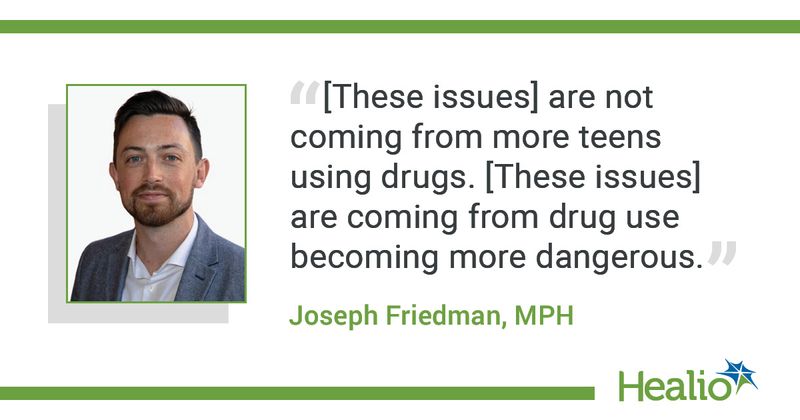Rate of teen overdose deaths soared during pandemic, study finds
The rate of overdose deaths among U.S. teenagers increased exponentially during the COVID-19 pandemic — a first — even as drug use remained stable, researchers found.
According to research published in JAMA, overdose deaths among teens nearly doubled in 2020 and rose another 20% in the first half of 2021 compared with the decade before the pandemic, in which teen drug use fell to historic lows.

Joseph Friedman, MPH, an MD/PhD candidate at the David Geffen School of Medicine at UCLA, said the idea for the study came from reports about counterfeit pills in circulation throughout the U.S.
“My co-authors and I had been learning a lot about counterfeit pills, which is really becoming kind of a key issue in terms of drug policy in the U.S.,” Friedman told Healio. “We've also seen a lot of media stories about teens who've overdosed on pills in the past couple of years. And we decided to see to what degree this is an issue nationally.”
The researchers examined data from the CDC on overdose deaths, the kinds of drugs used, and breakdowns by race, geography and ethnicity. What they found, Friedman said, was “quite alarming.”
“Overdoses among adults have been rising for about 4 decades,” Friedman said. “But during that time, teens were actually insulated from those increases. That is now starting to change for the first time.”
Although researchers previously reported unprecedented decreases in illicit drug use among teenagers during the pandemic, Friedman said a crucial contributor to the increase in overdose deaths is fake versions of prescription drugs such as Xanax, Percocet and Vicodin, whose strength can fluctuate.
“The increases are pretty much entirely explained by illicit fentanyl in counterfeit pills,” Friedman said. “[These issues] are not coming from more teens using drugs. [These issues] are coming from drug use becoming more dangerous.”
According to Friedman and colleagues, the rate of overdose deaths among adolescents aged 14 to 18 years remained “stable” from 2010 through 2019. There were 518 overdose deaths in 2010 — a rate of 2.4 per 100,000 teens — and 492 deaths in 2019, for a rate of 2.36 per 100,000. However, there was a sharp increase in 2020 to 954 deaths (4.57 per 100,000) and a further increase to 1,146 deaths (5.49 per 100,000) in early 2021.
Friedman said physicians, parents and adults working in school environments must “really help teens understand just how risky counterfeit pills can be.”
“Despite all of our efforts to try and get teens to not use drugs — which is, of course, a very important goal — we've never really been successful at that,” Friedman said. “So even now, with teen drug use at historic lows, it's still 40% of 12th graders reporting having experimented with other illicit drug at some point in their life. Teens are going to use drugs whether we like it or not, and what we need to do now is help those teens that decide to use drugs [get] accurate information about the risks of drugs at school.”
Friedman said teens should be aware that alcohol and cannabis, while not risk-free, are less risky than powders and pills for fentanyl. He also suggests providing naloxone to schools and other places where teens frequently congregate and educating them about how it is used.
“What we need to focus on here is giving these teens education and resources to stay safe,” Friedman said.
References:
Friedman J, et al. JAMA. 2022;doi:10.1001/jama.2022.2847.
